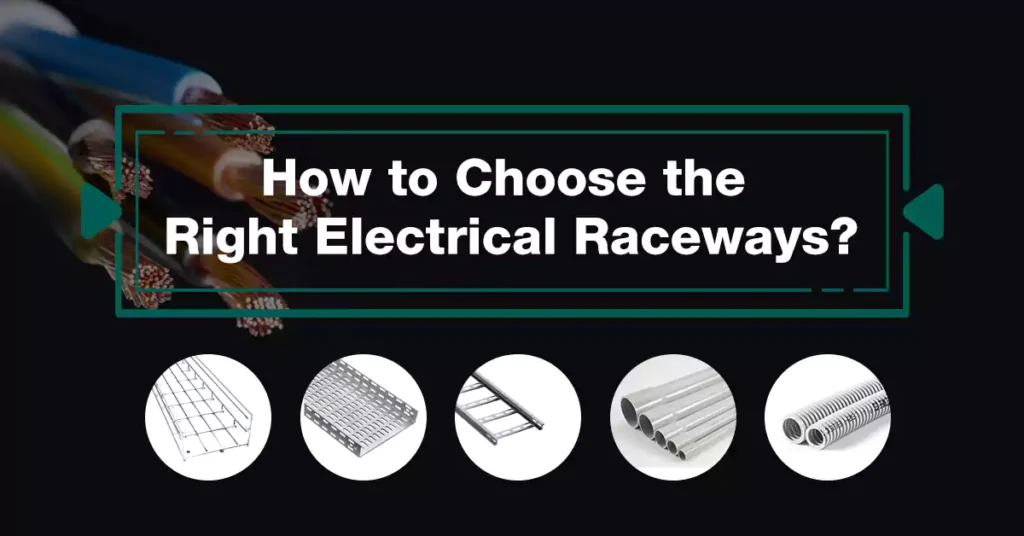
目录
电气系统是现代基础设施的支柱,为我们的家庭、办公室和工业提供电力。在这些系统中,各种组件在确保电气安装安全高效方面发挥着至关重要的作用。在这些组件中,电气管道、导管、电缆托盘和电气配件是促进电线分配和保护的重要元素。在本综合指南中,我们将深入研究电气管道、导管、电缆托盘和电气配件的世界,探索它们的定义、意义以及选择、安装等涉及的各个方面。
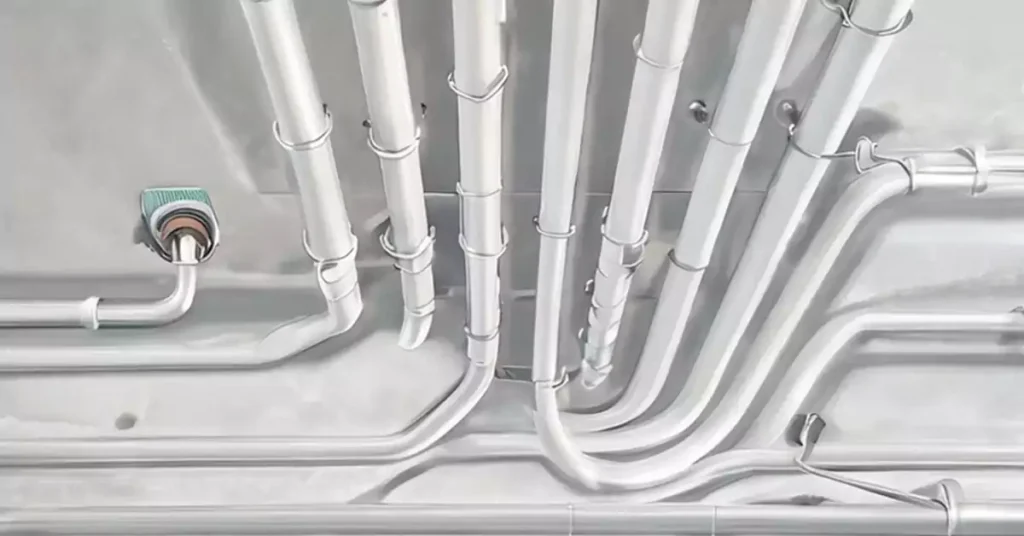
电气线槽是电线和电缆的保护通道,可确保安全有序地安装。它们可保护电线免受损坏、提高安全性、促进有序性并为将来的修改提供灵活性。
精心设计的电气管道系统具有多种优势,包括:
保护: 电气管道可保护电线和电缆免受物理损坏、潮湿、化学物质和其他外部因素的影响。在电线可能暴露于腐蚀性物质或机械应力的恶劣环境中,这种保护至关重要。
安全: 通过将电导体置于管道内,可显著降低意外接触或触电的风险。管道可提供额外的绝缘层和保护层,以防止电气事故。
组织: 线槽使电线和电缆排列整齐,最大限度地减少杂乱,简化维护和故障排除任务。这种组织方式提高了电气系统的效率和可访问性。
灵活性: 电气管道可使电路的修改、添加或重新布线更加容易。它们可灵活地适应不断变化的需求,而无需进行大量重新布线。
电气线槽通常由金属或非金属材料制成,有多种形式,例如导管和电缆托盘。线槽提供机械保护,防止电线损坏,并提供整洁有序的布线系统。我们将在本文中主要介绍电气线槽和电缆托盘两种不同的布线方法。
导管是一种电线管道,可为电导体提供保护通道。它通常用于住宅和商业环境中,以布线和保护电线和电缆。导管有多种用途:
保护: 导管为电线和电缆提供物理保护,保护它们免受冲击、潮湿和其他环境危害。它可以防止意外损坏并延长电气系统的使用寿命。
路由: 导管为电导体提供明确界定的路径,确保安装有序且结构化。它简化了故障排除、维护和未来修改。
接地: 金属导管如果安装和粘合得当,可以作为有效的接地通道,降低触电风险并提供故障电流路径。
常见的导管类型有四种:刚性金属导管 (RMC)、中间金属导管 (IMC)、电气金属管 (EMT) 和 PVC 导管。根据耐用性、灵活性、成本效益和对环境因素的抵抗力等因素选择适当的导管类型。
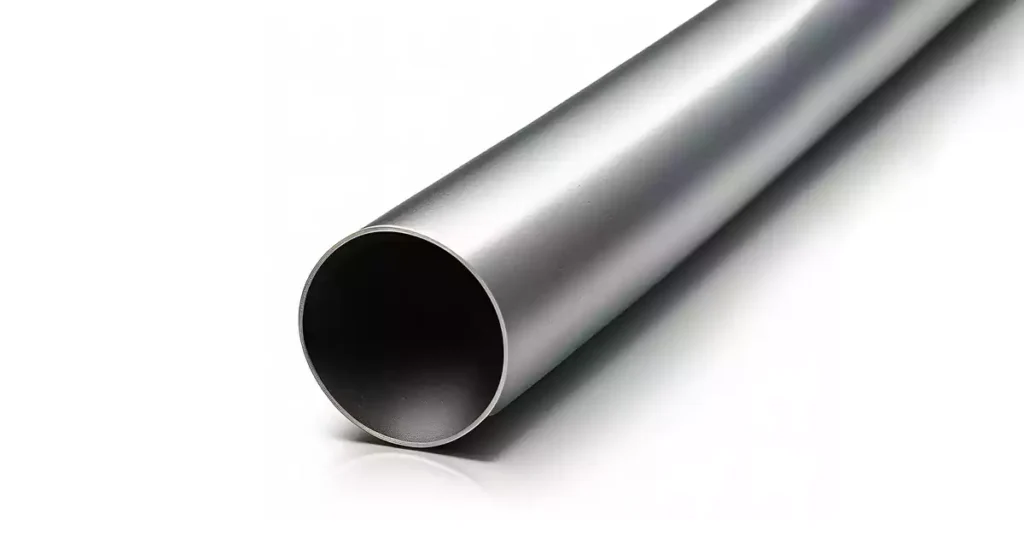
RMC 是一种由钢制成的重型导管。它提供卓越的机械保护,并且具有很强的抗冲击和抗压缩能力。RMC 通常用于耐用性和坚固性至关重要的工业和商业环境。
特征: 重型、厚壁导管,带螺纹端,可实现安全连接。提供最高级别的机械保护和出色的电磁屏蔽。
好处: 卓越的耐用性、抗冲击性和 EMI 保护。非常适合工业和高风险环境。
注意事项: 需要专门的工具进行切割和穿线。如果没有适当的涂层,容易腐蚀。安装人工和成本相对较高。
IMC 是一种重量较轻的导管,同样由钢制成。它提供与 RMC 类似的机械保护,但灵活性更高,安装更方便。IMC 通常用于需要适度物理保护的商业和工业应用。
特征: 比 RMC 更轻,壁更薄。使用螺纹连接或压缩配件,安装方便。
好处: 与 RMC 相比,具有良好的机械保护性能,同时提供更大的灵活性和成本效益。适用于商业和工业应用。
注意事项: 需要正确接地以形成有效的故障电流路径。在某些环境下易受腐蚀。
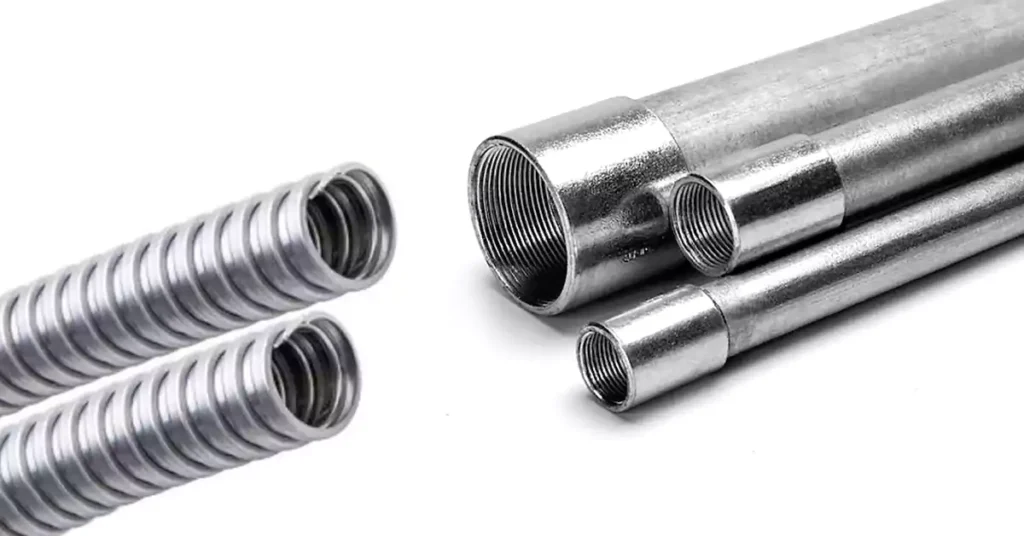
EMT 是一种由镀锌钢或铝制成的薄壁导管。它重量轻、易于安装且成本效益高。EMT 通常用于中等机械保护就足够的住宅和商业环境。
特征: 薄壁导管,内部光滑,便于拉线。使用压缩配件或固定螺钉连接器可快速安装。
好处: 重量轻、经济高效且易于使用。是中等机械保护就已足够的住宅和商业应用的理想选择。
注意事项: 在恶劣环境或易受物理损坏的区域提供有限的保护。
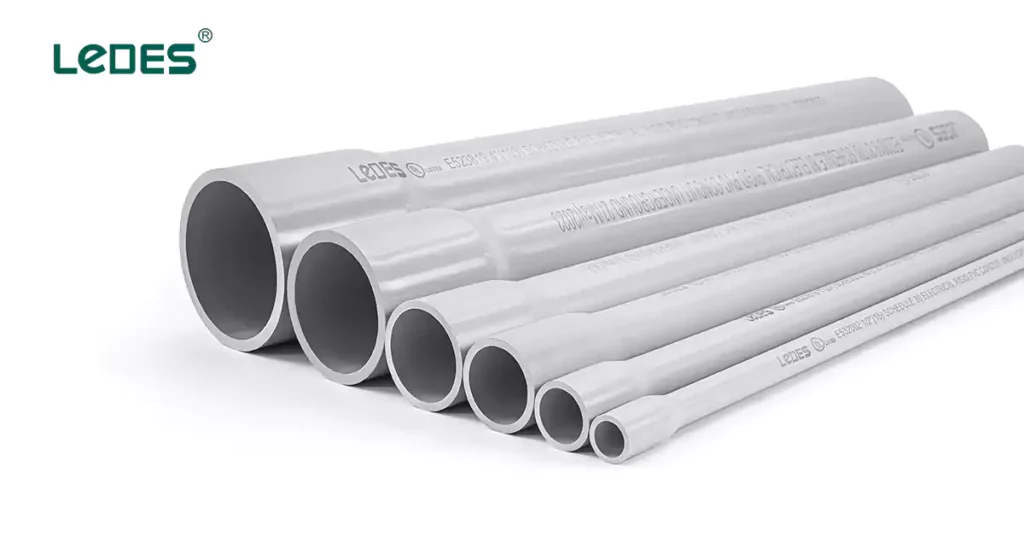
PVC 导管是一种由聚氯乙烯制成的非金属导管。它重量轻、耐腐蚀,并具有出色的耐化学性。PVC 导管广泛用于需要适度机械保护的住宅和商业应用。
特征: 由 PVC 制成的非金属导管,有各种尺寸和配置可供选择。使用溶剂焊接或推入式连接器,安装简单。
好处: 重量轻、耐腐蚀、经济实惠。具有出色的耐化学性,适合地上安装。
注意事项: 与金属导管相比,机械强度有限,且抵抗极端温度的能力降低。
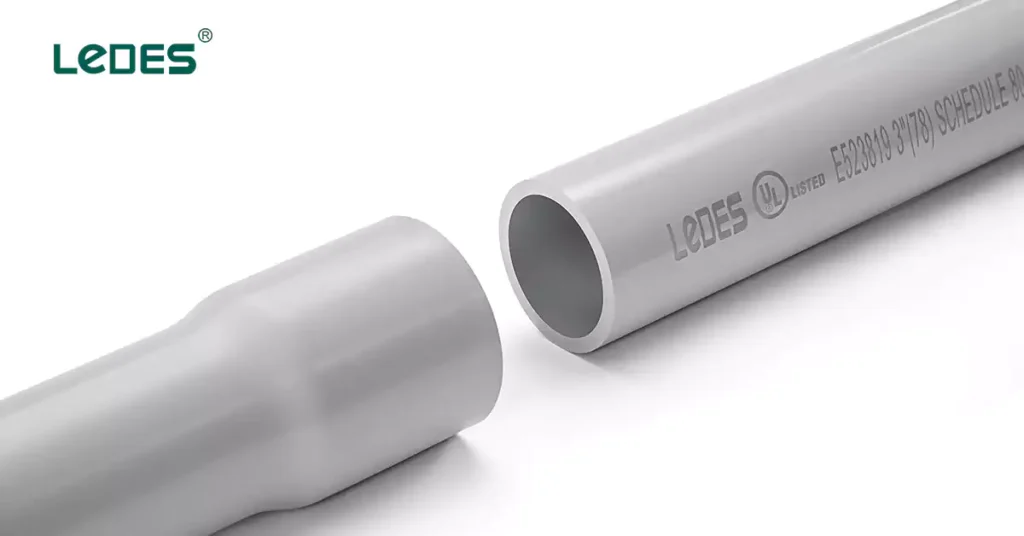
遵循导管安装指南和最佳实践:正确安装导管对于安全和性能至关重要。规划导管路径、考虑尺寸、确保安装和支撑牢固、进行准确的连接和配件、将导管接地以确保电气安全、拉动和固定电线、密封导管、标记线路,并在通电前检查和测试安装。
- 路线规划: 确定最佳管道路径,考虑可达性、布线限制和间隙要求。规划扩展和未来维护需求。
- 浆纱: 根据要安装的导线数量和尺寸选择合适的导管尺寸。确保有足够的空间用于将来的扩展。遵守当地电气规范和规定。
- 安装和支撑: 使用适当的支撑和紧固件将导管牢固地固定在墙壁、天花板或其他结构元件上。确保适当的支撑间距以避免下垂或过度压力。使用专为导管设计的夹具或吊架。
- 弯曲和切割: 使用专用工具将导管正确弯曲至所需角度。遵循导管制造商提供的弯曲表或指南。使用适当的切割工具将导管切割至所需长度。
- 连接和配件: 使用适合导管类型的经批准的连接器、联轴器和配件。确保正确对齐和紧密连接。按照制造商的说明进行安装。
- 接地: 确保金属导管正确接地,以提供有效的故障电流路径并降低触电风险。使用认可的方法将导管连接到接地导体。
- 拉动和固定电线: 小心地将电线和电缆安装在导管内,以免损坏。使用适当的润滑剂和拉动工具,以尽量减少摩擦。定期固定电线,以防止移动,并尽量减少连接处的压力。
- 密封: 密封导管配件和连接,以防止湿气、灰尘或其他污染物进入。使用经批准的密封材料或适合特定导管类型和环境条件的方法。
- 标签: 正确标记导管和接线盒,以便于识别和排除故障。使用永久性标记或可承受环境条件的标签。
- 检查和测试: 在通电前对导管安装进行彻底检查。执行连续性和绝缘电阻测试,以确保正确的电气连接和安全。
电气导管在住宅、商业和工业环境中有各种应用。以下是一些常见示例:
住宅应用:
– 在新房建设或改造项目中布置电线。
– 保护户外设施中的电导体,例如景观照明或电动汽车充电站。
– 保护并整理家庭影院系统或计算机网络的电缆。
商业应用:
– 在办公楼、零售店和教育机构安装电气系统。
– 为 HVAC 系统、照明设备和安全系统布线电源和控制线路。
– 连接数据中心或服务器机房的电气设备。
工业应用:
– 管理制造设施和工业厂房的电力分配。
– 保护危险环境中的电线,例如化工厂或炼油厂。
– 工业机械和设备的路由控制和仪表布线。
UL、CSA、NEMA 和 IEC 等标准组织提供测试和认证服务,以确保电气导管的安全性、性能和兼容性。
UL(美国保险商实验室): UL 是一家全球安全认证公司,为包括导管在内的各种电气产品提供测试和认证。 UL 标准 确保导管满足特定的安全和性能要求。
CSA(加拿大标准协会): CSA 是一家独立组织,负责制定标准并提供测试和认证服务 加拿大的电气产品.CSA 标准确保导管符合加拿大的安全和性能要求。
NEMA(美国电气制造商协会): NEMA 是电气设备和医学成像制造商的协会。NEMA 为导管和其他电气产品提供标准,以确保兼容性、安全性和性能。
IEC(国际电工委员会): IEC 是一个国际标准组织,负责制定和发布各种电气技术的标准。 IEC 标准 得到世界范围的认可并确保全球一致性和互操作性。
遵守这些标准有助于确保导管安装的质量和可靠性,让您安心无忧,并满足不同地区的监管要求。
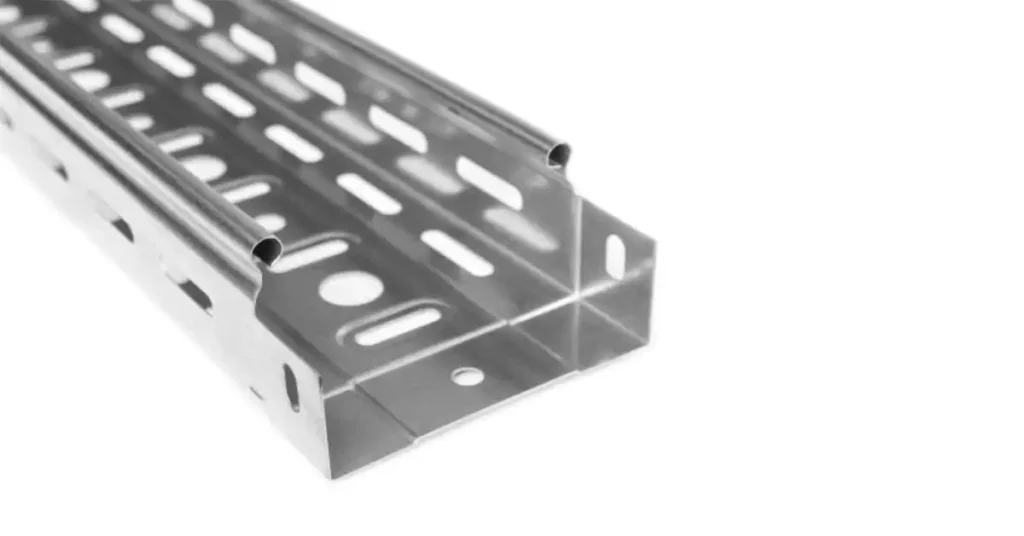
电缆托盘是电气设备中用于组织和保护电缆和电线的支撑系统。它们提供电缆管理、机械保护、电磁兼容性以及维护和故障排除的便利性。
电气装置中电缆桥架的用途包括:
电缆管理: 电缆托架为电缆的布线和支撑提供了结构化的通道,使电缆保持有序,防止缠绕或损坏。
机械保护: 电缆托架可保护电缆免受冲击、磨损或环境因素等外部危害,确保电缆的使用寿命和可靠性。
电磁兼容性: 电缆托架可以通过适当分离和接地电缆来帮助管理电磁干扰 (EMI)。
可访问性和维护: 电缆托架可轻松访问电缆,以便进行维护、故障排除以及未来的安装或更换。
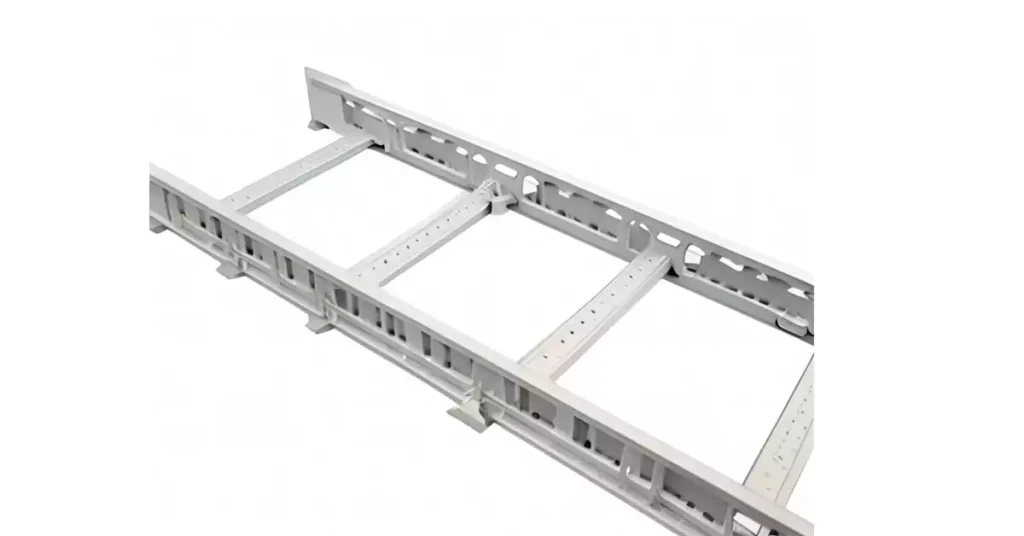
电缆托盘有六种类型:梯形电缆托盘、实心底电缆托盘、通风电缆托盘、金属网电缆托盘、通道电缆托盘和槽式电缆托盘。每种类型都有自己的设计和构造特点,适合特定的应用和环境条件。
梯子电缆托架: 梯形电缆托架由两个纵向侧轨组成,通过横档连接,类似梯子结构。它们提供良好的通风,并且从顶部和底部都易于进入。
实心底部电缆桥架: 实心底电缆托盘具有坚固的底座,可提供额外的防尘、防污和防潮保护。它们适用于对电缆进行外部保护至关重要的环境。
通风电缆桥架: 通风式电缆托盘沿其长度方向有穿孔或槽,可增加气流和散热。它们通常用于电缆冷却至关重要的区域,例如高温环境。
金属网电缆桥架: 金属网电缆托盘采用由相互连接的金属线制成的网格状结构。它们提供良好的电缆可视性、灵活性和气流,同时保持电缆的支撑和保护。
通道电缆托盘: 通道电缆托盘采用 U 形设计,适用于轻型电缆或导管。它们可从顶部轻松接入电缆。
槽式电缆桥架: 槽式电缆托盘具有深而矩形的横截面,非常适合管理大量电缆或笨重电缆。
与导管相比,电缆托盘具有灵活性和可扩展性、更好的气流、可访问性和成本效益。但是,它们可能会将电缆暴露在外部环境中,并且提供的物理保护有限。
灵活性和可扩展性: 电缆托架可以更轻松地重新配置以及将来添加或修改电缆,从而灵活地适应不断变化的电力需求。
改善气流: 带有通风装置的电缆托架可以使电缆周围的空气更好地流通,从而降低过热风险并提高电缆性能。
可访问性: 电缆托架可轻松接入电缆,简化维护、故障排除和升级。
经济高效: 电缆桥架比导管系统更具成本效益,特别是对于需要大量电缆的安装而言。
暴露于外部元素: 电缆桥架可能会将电缆暴露在灰尘、湿气和其他环境因素中,因此需要正确选择电缆并定期检查。
有限保护: 与导管相比,电缆桥架对冲击和外部危害提供的物理保护较少。
能见度: 在某些情况下,与导管系统相比,电缆桥架可能会使视觉追踪电缆路径变得更具挑战性。
选择和安装电缆桥架时,请考虑以下因素:
- 负载能力: 确保所选的电缆桥架具有足够的承载能力,以支撑电缆的重量和可能施加的任何额外负载。
- 环境条件: 选择适合特定环境的电缆桥架,考虑温度、湿度、腐蚀性物质和紫外线照射等因素。
- 电缆类型和尺寸: 选择能够容纳所安装电缆类型和尺寸的电缆托架。考虑未来的电缆扩展需求。
- 安装位置: 确定电缆桥架是安装在室内、室外还是危险场所,并据此选择合适的材料和涂层。
- 支撑和安装: 确保使用适当的支撑和安装方法将电缆托架牢固地固定到墙壁、天花板或其他结构上。考虑温度变化引起的膨胀和收缩。
- 接地和接合: 遵守接地和接合要求以维护电气安全并最大限度地减少电磁干扰。
- 守则合规性: 选择和安装电缆桥架时,请遵守当地的电气规范、法规和行业标准。
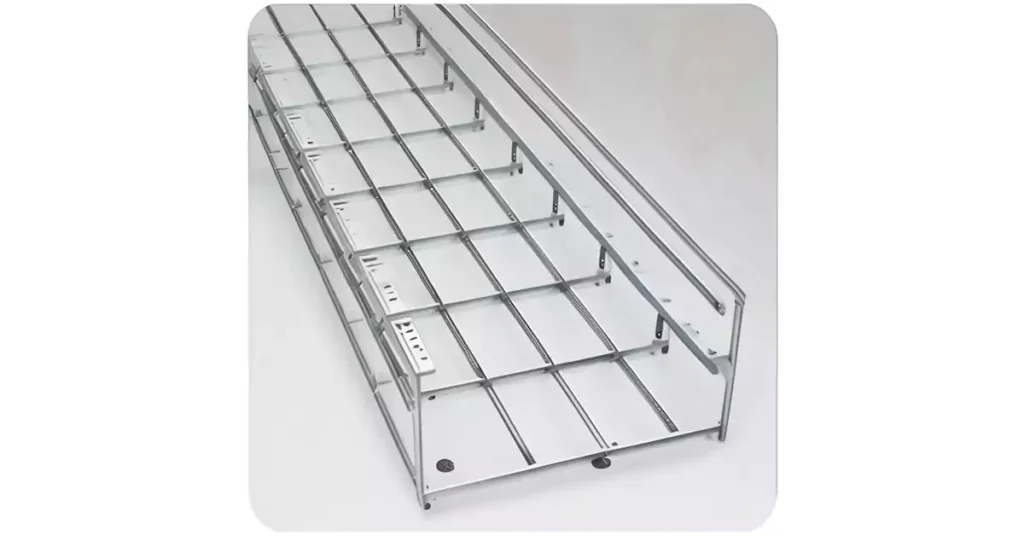
电缆桥架可用于各种环境,包括:
- 商业建筑: 电缆桥架用于办公楼、商场、医院、教育机构等的电缆布线和管理。
- 工业设施: 电缆托架通常用于制造厂、炼油厂、发电厂和化学加工厂,以在恶劣和苛刻的环境中组织和保护电缆。
- 数据中心: 电缆托架广泛用于数据中心和服务器机房,以管理配电、数据通信和冷却系统的复杂电缆网络。
- 交通基础设施: 电缆桥架用于机场、地铁系统和火车站等交通基础设施,以布置和保护照明、信号和通信系统的电缆。
- 户外设施: 具有适当涂层和防风雨措施的电缆桥架可用于街道照明、交通控制系统和室外配电等户外设施。
电缆桥架可分为有盖桥架和无盖桥架,其选择取决于应用和环境条件:
- 带盖托盘: 带盖电缆托盘配有保护盖,可保护电缆免受灰尘、湿气和物理损坏等外部因素的影响。它们适用于室内安装或需要额外保护的区域。
- 未盖盖子的托盘: 无盖或开放式电缆托盘便于电缆接入,通常用于注重电缆管理和可达性的室内环境。由于易受环境因素影响,它们通常不适合户外应用。
- 室内使用: 在室内应用中,可以根据负载能力、电缆类型和尺寸要求以及美观考虑来选择电缆托架。它们提供灵活性和易于访问的电缆,同时确保适当的电缆管理。
- 户外使用: 对于室外安装,应根据电缆架承受天气条件、紫外线照射和腐蚀性元素的能力来选择电缆架。防风雨涂层、耐环境因素的材料和适当的接地对于室外电缆架安装至关重要。
咨询当地电气规范、法规和制造商指南非常重要,以确保正确选择、安装和维护适合室内和室外使用的电缆桥架。
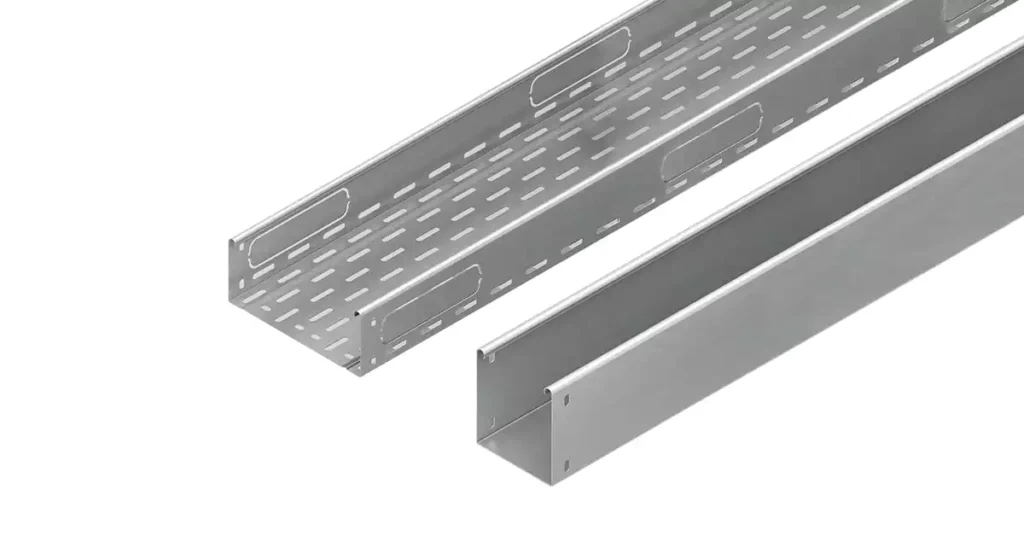
电缆托盘的标准和规范可能因地区和管辖区而异。但是,有几种广泛认可的标准和规范为电缆托盘的设计、安装和使用提供了指导。以下是一些常用的标准和规范:
国家电气规范 (NEC)
美国保险商实验室 (UL)
加拿大电气规范 (CEC)
国际电工委员会(IEC)
英国标准 (BS)
电气配件是电气安装中用于连接、固定和保护电气设备、装置和线路的部件。它们在确保电气系统安全高效运行方面发挥着至关重要的作用。电气配件有助于正确安装、布线和连接电导体和设备,同时确保符合电气规范和标准。
电气金具的重要性可概括为以下几点:
安全: 电气配件提供机械支撑、针对环境因素的保护和安全的电气连接,最大限度地降低短路、触电和火灾等电气危险的风险。
可靠性: 正确选择和安装的电气配件可确保可靠的电气连接,从而降低设备故障、电源中断和操作问题的可能性。
方便: 电气配件可使布线整齐有序,使电气系统的管理和维护更加容易。它们有助于故障排除、维修和升级。
以下是一些用于导管和电缆桥架的常见电气配件类型及其材料、安装方法和性能特点:
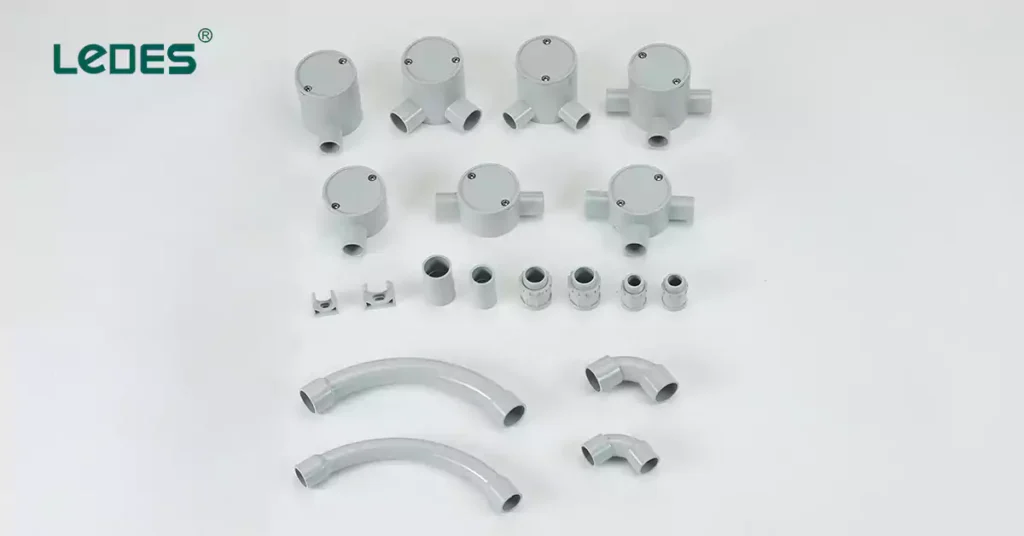
- 导管连接器: 导管连接器用于将两段导管连接在一起或将导管连接到电气箱或外壳。它们有多种类型,例如压缩连接器、固定螺钉连接器和推入式连接器。导管连接器通常由钢、铝或 PVC 等材料制成。它们通过拧紧螺钉或压缩配件进行安装,确保连接牢固且防水。
- 导管弯头: 导管弯头用于改变导管的走向,为电线布线提供灵活性。它们有不同的角度,例如 90 度或 45 度,可以由钢或 PVC 等材料制成。导管弯头的安装方式是将其连接到导管的末端,以便平稳地改变方向。
- 导管接头: 导管接头用于将两段导管以直线连接起来。它们有不同的尺寸和材质,包括钢、铝或 PVC。导管接头通过拧紧螺钉或使用压缩配件进行安装,确保导管安全连续运行。
- 导管带: 导管带用于将导管固定到墙壁、天花板或其他表面上。它们提供支撑并防止过度移动或振动。导管带可以由钢、铝或塑料等材料制成。它们的安装方法是将其连接到表面上并将导管固定在带子内。
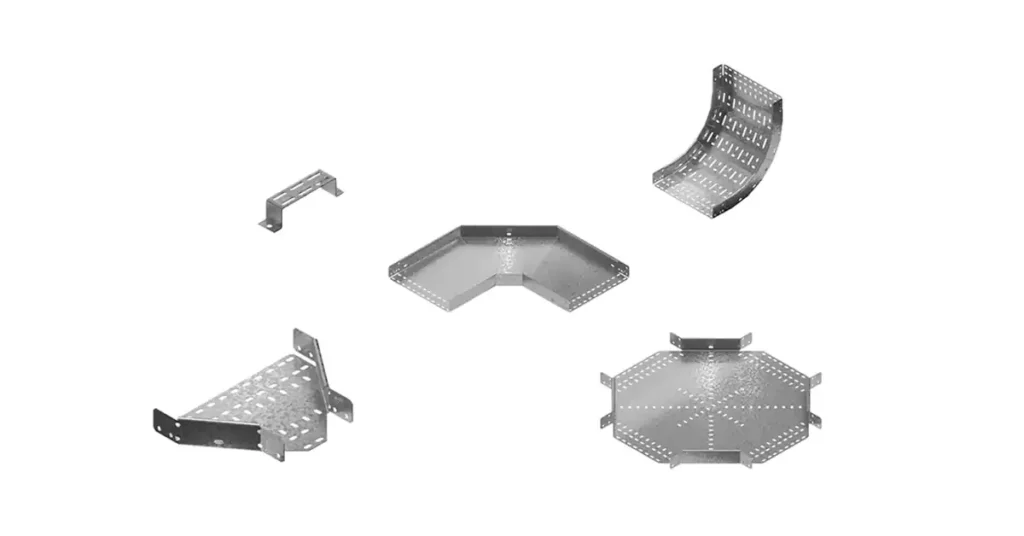
- 直截面: 直管段是电缆托盘的主要部件,为电缆提供通道。它们有各种宽度、深度和材料,例如钢、铝或玻璃纤维。直管段的安装方法是将它们连接在一起,以形成连续的电缆托盘。
- 弯道和转弯: 弯头和转弯用于改变电缆托盘的运行方向。它们有不同的角度,例如 90 度或 45 度,可以由钢或铝等材料制成。弯头和转弯通过将其连接到电缆托盘的直线部分来安装,从而实现平稳的方向变化。
- 三通和十字通: 三通和十字接头用于在电缆托盘系统中创建交叉点或分支点。它们允许分离电缆或连接多个电缆托盘。三通和十字接头通过将其连接到电缆托盘的直线部分进行安装,提供多种布线选项。
- 支撑架: 支撑架用于将电缆托盘固定并支撑到墙壁、天花板或其他结构上。它们提供稳定性并防止下垂或过度移动。支撑架可以由钢或铝等材料制成。它们的安装方法是将其连接到表面并将电缆托盘固定在支架内。
选择电气配件时,请考虑应用和环境、材料兼容性、尺寸和容量、法规遵从性以及安装的简易性等因素。请遵循制造商的建议,选择合适的配件并考虑兼容性。
电气安全: 选择符合电气规范和标准的配件可确保电气连接的完整性并降低短路、电弧和过热等电气危险的风险。
可靠的性能: 兼容的配件可确保可靠的电气连接,最大限度地减少连接松动、电压下降和设备故障的可能性。合适的配件还有助于长期保持电气系统的性能。
遵守: 选择符合电气规范和法规的配件有助于确保安装符合安全要求并避免潜在的法律问题或处罚。
环境保护: 适合安装环境的配件可防止潮湿、灰尘、化学物质和其他环境因素,保护电气系统免受损坏或性能下降。
安装简便: 兼容配件更易于安装,可减少安装时间和精力。它们还可以高效地布线和连接电导体,从而提高整体安装质量。
选择电气配件时,应考虑6个因素:
应用与环境: 考虑配件的具体用途和使用环境条件。应评估温度、湿度、腐蚀性元素和物理应力等因素,以确保配件适合预期环境。
材料兼容性: 确保配件所用材料与电气系统中的导管、电缆托盘和其他组件的材料兼容。不兼容的材料会导致腐蚀、导电性差和性能下降。
尺寸和容量: 选择适合所安装电导体或电缆的尺寸和容量的配件。尺寸过大或过小的配件都可能导致连接不良、过热或限制未来的系统扩展。
守则合规性: 验证所选配件是否符合相关电气规范和标准。这可确保安装符合安全要求和监管准则。
安装简便: 考虑配件的安装方法和要求。选择易于安装且连接牢固的配件,无需复杂或耗时的程序。
制造商的建议: 遵循制造商关于配件选择、安装和兼容性的建议和指南。制造商通常会提供有关其配件的正确使用和限制的宝贵信息。
通过仔细考虑这些因素并选择合适的电气配件,您可以确保安全、可靠且合规的电气安装。
电气管道、导管、电缆托盘和配件共同作用,保护、布线和支撑电线或电缆。管道用于管道内以保护单根电线,而电缆托盘则提供支撑和组织多根电缆的框架。配件在连接和端接这些组件时起着至关重要的作用。
这些组件之间的关系基于它们的功能集成。导管用于线槽内以保护单根电线,而电缆托盘则提供用于支撑和组织多根电缆的框架。配件在连接和端接这些组件方面起着至关重要的作用,可确保电气安装安全可靠。
通过结合这些元素,电气专业人员可以创建一个设计精良且高效的配电系统。线槽、导管、电缆托盘和配件的选择取决于应用、环境、布线要求和当地电气规范等因素。
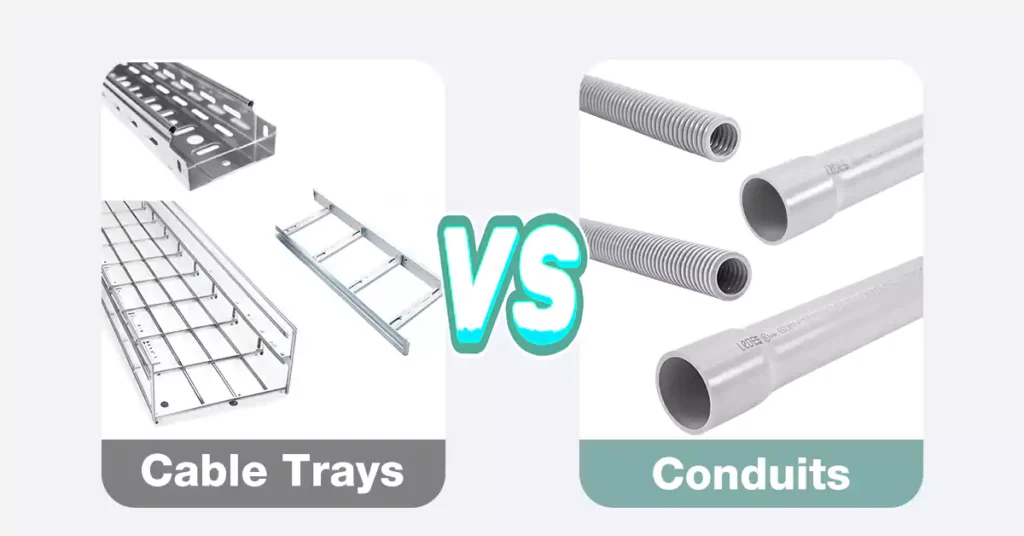
根据项目需求选择导管和电缆托盘,考虑环境条件、电缆容量、安装灵活性和规范要求等因素。咨询电气专业人士或工程师,获取针对您特定项目的指导。
导管: 非常适合工业环境、户外安装、高振动区域或 EMI 屏蔽和防火很重要的区域,例如制造工厂、石化设施或数据中心。
电缆托盘: 非常适合商业建筑、频繁修改的大型项目、电缆密度高的项目或涉及数据和通信电缆的应用,例如办公楼、大学或电信设施。
评估项目需求、考虑环境条件、电缆容量、安装灵活性和规范要求等因素,以便在导管和电缆托盘之间做出明智的决定至关重要。咨询电气专业人士或工程师也可以为您的特定项目提供有价值的见解和指导。
总之,这些组件不仅可以保护电缆免受物理损坏、潮湿和环境因素的影响,还可以确保正确的电缆管理、可访问性和 EMI 屏蔽。根据项目要求选择正确的选项对于确保高效、无故障的电气安装至关重要。
正确选择和安装电气管道对于遵守行业标准、法规和安全准则至关重要。它可确保保护电缆,最大限度地降低电气故障和故障风险,并方便维护和故障排除。
必须仔细考虑保护要求、灵活性、容量、环境条件和 EMI 屏蔽等因素。这将有助于在导管和电缆托盘之间做出明智的决定。通过选择和安装适当的电气管道系统,可以实现电气系统的合规性、保护性和无故障使用,从而确保整个电气基础设施的可靠性和使用寿命。如果您对电气系统保护解决方案有任何疑问,请随时通过以下方式与我们联系: 提交表格 或者 向我们发送电子邮件。



